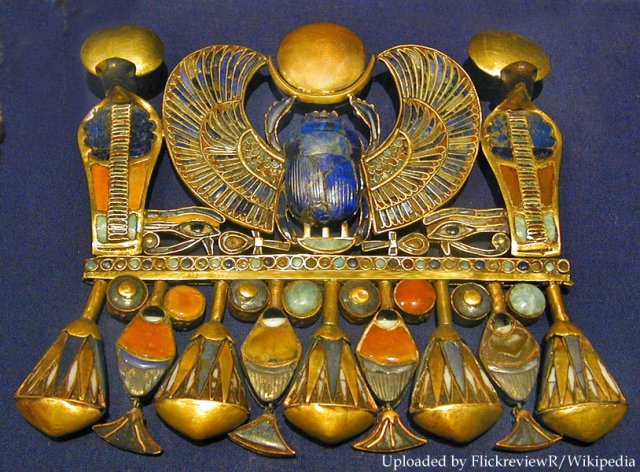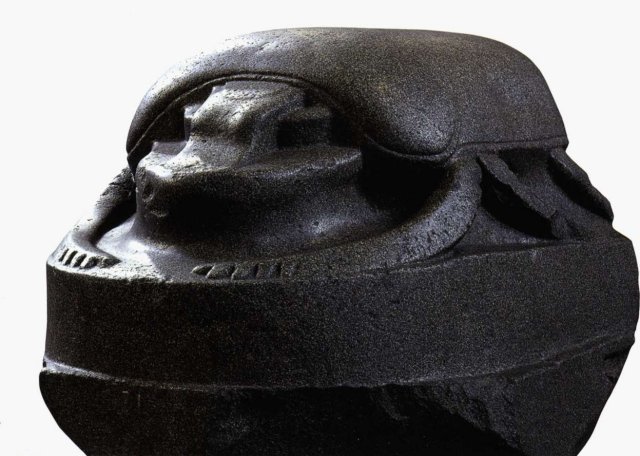Secrets Of The Scarab – Ancient Sacred Symbol In Human History
A. Sutherland - AncientPages.com - Ornaments in the shape of beetles are known from the late Paleolithic epoch (10,000 to 20,000 years ago). However, so much earlier than the Egyptian civilization, it is difficult to know the exact meaning these people attributed to beetle body ornaments.
Statue of Khepri, the sacred scarab in Karnak Temple Complex Luxor. Credit: Adobe Stock - Mountains Hunter
Scarab is one of the ancient Egyptians' oldest and most widely used symbols. Egyptian pharaohs worshipped dung beetles; most probably, it was symbolically as sacred to the Egyptians as the cross is to Christians.
The scarabs with aesthetic qualities and shamanic symbolism were already known in the Old Kingdom (3rd millennium BC) and played an important role in the early worship of animals. It is supported by archaeological evidence discovered in graves during the time of King Den of Dynasty I.
Sir W. M. Flinders Petrie, in Scarabs and cylinders with names, writes that many different kinds of beetle were sacred and venerated in ancient Egypt. Evidence of this can be seen on many jars, found in graves containing numerous dried beetles, both large and small, and many amulets, especially in the form of large sacred Scarabeus sacer.
Particularly well-known is an amulet depicting 'the sun - the big ball rolled across the heaven by the Creator, and the scarab is an emblem of the Creator, Khepera...' or the sun god Khepri (Kheper (a), in the mythology of ancient Egypt, 'the Father of the Gods' and this symbolism of the beetle is a part of the primeval animal worship of ancient Egypt.
The 'Kheper' is 'being' and means existence, creation, or becoming; so, the god Khepera is the self-existent creator god.'
Winged scarab of Tutankhamun with semi-precious stones. This pectoral is composed of Tut's Prenomen name: "NebKheperU-Ra", the hieroglyphs of: Basket, Scarab-(in Plural-strokes), and Re. Credit: Jean-Pierre Dalbéra, Flickr - CC BY 4.0
The scarab was depicted with the disc of Ra in its claws in the 12th, 18th, and later dynasties and associated with other gods as a creative emblem.
Millions of amulets and stamp seals of stone or faience were fashioned in Egypt with depictions of the scarab beetle, and this tradition survived well beyond the dynastic periods.
'On the passing to the 23rd dynasty and later the winged scarab was placed on the breast of the mummies, as the emblem of the Creator, who will transform the dead, and from the 26th to the 30th dynasties, many scarabs were placed on the mummy, usually a row of half a dozen or more along with the figures of the gods.' (W.M.F.Petrie)
Ornament from an ancient Egyptian sarcophagus with Scarab Beetle. Credit: Adobe Stock - Juulijs
In Roman times, there were various kinds of beetles and the Greeks adopted the carved stone columns, which seems to confirm the importance of the sacred temples of the Egyptian scarabs:
"I am Cheprer, a student, and when I spread wings, back to life."
The sacred 'Chilam Balam' books written by the Maya describe the scarab as a dirt ground, in terms of material and moral, which is destined to become a saint, and in China, we find the same symbolic interpretation in 'the scarab rolls its ball, which is called by life.'
'The scarabaeus rolls his ball and in the ball there develops life as the result of the undivided effort of his spiritual concentration. If now an embryo can grow in manure and shed its shells, why then should not the dwelling place of our heavenly heart also be able to create a body if we concentrate the spirit upon it..? we read in the 'The Secret of the Golden Flower" - A Chinese Book of Life, translated in 1931).
The famous text of “The Secret of the Golden Flower,” takes the sacred scarab as an example of the “work to be done” to reach spiritual immortality, either material (for the body), or spiritual (for the soul).
This is a giant sculpture of a scarab beetle. It is around one and a half meters long and is one of the largest known representations of a scarab beetle. This scarab is thought to be from the Ptolemaic period (305-30 BC) but could be earlier. It may once have stood in an Egyptian temple but it was found in Constantinople (modern Istanbul) in Turkey. It may have been taken from Egypt to Constantinople when the city became the capital of the Later Roman Empire in AD 330. Image credit: British Museum.
It is a goal of the Taoism philosophy, which believes in the strengths of various material “pellets” that aid in reaching immortality.
The scarab dung ball was identified as one of these important 'pellet substances'.
Many beetle species have been and still are used as food in America, Australasia, Asia, and Africa; some were also eaten in Europe. Through Art Nouveau jewelry of the 1900s, Western civilization was richly adorned with beetles and other insects.
In Europe and North America, collars, broaches, and ear pendants used beetles mounted on bronze. Today, especially in Mexico, living specimens of some beetle species are worn by women as broaches, attached with a small gold or bronze chain.
By the way, some say that the scarab worn as a pendant around the neck can cause disease of the throat and larynx. Or is it only an illusion...?
Updated on February 23, 2024
Written by A. Sutherland - AncientPages.com Senior Staff Writer
Copyright © AncientPages.com All rights reserved. This material may not be published, broadcast, rewritten or redistributed in whole or part without the express written permission of AncientPages.com
Expand for referencesReferences:
Myer, I. Scarabs The History, Manufacture and Symbolism of the Scarabæus
in Ancient Egypt, Phoenicia, Sardinia, Etruria, etc.
More From Ancient Pages
-
 Ancient Burial Of Woman Equipped With A Unique Gold Pectoral Ornament Discovered In Siberian ‘Valley Of The Kings’
Archaeology | Feb 15, 2022
Ancient Burial Of Woman Equipped With A Unique Gold Pectoral Ornament Discovered In Siberian ‘Valley Of The Kings’
Archaeology | Feb 15, 2022 -
 Climate Change Will Soon Erase Ancient Cave Art Of Sulawesi, Indonesia
Archaeology | May 17, 2021
Climate Change Will Soon Erase Ancient Cave Art Of Sulawesi, Indonesia
Archaeology | May 17, 2021 -
 Unusual 6,000-Year-Old Gold Objects Discovered In Hungarian Tombs – More Mysterious Conical Hats?
Archaeology | Mar 25, 2021
Unusual 6,000-Year-Old Gold Objects Discovered In Hungarian Tombs – More Mysterious Conical Hats?
Archaeology | Mar 25, 2021 -
 Huge 36-Million-Year-Old Skull Of Fearsome Marine Monster Discovered In Peru
Fossils | Mar 21, 2022
Huge 36-Million-Year-Old Skull Of Fearsome Marine Monster Discovered In Peru
Fossils | Mar 21, 2022 -
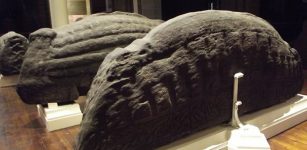 The Govan Stones – Treasures From The Viking Era In Britain
Featured Stories | Dec 27, 2015
The Govan Stones – Treasures From The Viking Era In Britain
Featured Stories | Dec 27, 2015 -
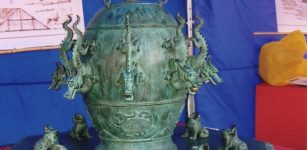 Zhang Heng Seismograph Could Record Earth’s Dangerous Movements
Artifacts | Mar 8, 2023
Zhang Heng Seismograph Could Record Earth’s Dangerous Movements
Artifacts | Mar 8, 2023 -
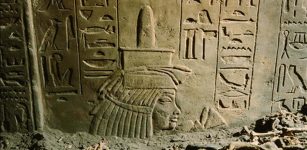 Tomb Of Maia, Tutankhamun’s Wet Nurse In Egypt’s Saqqara Opens To Public
Archaeology | Dec 22, 2015
Tomb Of Maia, Tutankhamun’s Wet Nurse In Egypt’s Saqqara Opens To Public
Archaeology | Dec 22, 2015 -
 1,600-Year-Old Pendants Depicting Humans And Animals Excavated In Ancient Port-City Of Assos
Archaeology | Jan 21, 2020
1,600-Year-Old Pendants Depicting Humans And Animals Excavated In Ancient Port-City Of Assos
Archaeology | Jan 21, 2020 -
 Easter Island Secrets: Giant ‘Pukao’ Stone Hats Reveal That Rapa Nui People Were Not Warriors
Archaeology | Dec 22, 2017
Easter Island Secrets: Giant ‘Pukao’ Stone Hats Reveal That Rapa Nui People Were Not Warriors
Archaeology | Dec 22, 2017 -
 Excavation Of A Mysterious 5,000-Year-Old Tomb Linked To King Arthur Has Started
Archaeology | Jul 5, 2022
Excavation Of A Mysterious 5,000-Year-Old Tomb Linked To King Arthur Has Started
Archaeology | Jul 5, 2022 -
 Earliest Evidence Of Flip Flops In The Middle Stone Age
Archaeology | Oct 27, 2023
Earliest Evidence Of Flip Flops In The Middle Stone Age
Archaeology | Oct 27, 2023 -
 Did Ancient Romans Reach The Americas Long Before Columbus?
Civilizations | May 19, 2021
Did Ancient Romans Reach The Americas Long Before Columbus?
Civilizations | May 19, 2021 -
 Completely Intact 2,000-Year-Old ‘Chocolatier Style’ Pot Discovered In Mexican Cave
Archaeology | Jul 30, 2022
Completely Intact 2,000-Year-Old ‘Chocolatier Style’ Pot Discovered In Mexican Cave
Archaeology | Jul 30, 2022 -
 Graeae: Three Sisters Of Fate Who Shared One Eye And Tooth In Greek Mythology
Featured Stories | Jun 8, 2016
Graeae: Three Sisters Of Fate Who Shared One Eye And Tooth In Greek Mythology
Featured Stories | Jun 8, 2016 -
 Remote North Atlantic Islands Were Settled By An Unknown Group Of Humans Centuries Earlier Than Thought
Archaeology | Dec 27, 2021
Remote North Atlantic Islands Were Settled By An Unknown Group Of Humans Centuries Earlier Than Thought
Archaeology | Dec 27, 2021 -
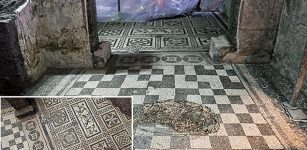 Ancient Roman ‘Commander House’ Discovered In Rome
Archaeology | Mar 5, 2018
Ancient Roman ‘Commander House’ Discovered In Rome
Archaeology | Mar 5, 2018 -
 On This Day In History: Crew Of Discovery Launches Mutiny Against Captain Henry Hudson – On June 22, 1611
News | Jun 22, 2016
On This Day In History: Crew Of Discovery Launches Mutiny Against Captain Henry Hudson – On June 22, 1611
News | Jun 22, 2016 -
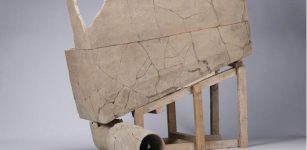 2,400-Year-Old Flush Toilet Discovered In China
Archaeology | Feb 24, 2023
2,400-Year-Old Flush Toilet Discovered In China
Archaeology | Feb 24, 2023 -
 Unique Finds Discovered In Oman – Rub’al-Chali Desert Reveals Its Secrets
Archaeology | Apr 20, 2023
Unique Finds Discovered In Oman – Rub’al-Chali Desert Reveals Its Secrets
Archaeology | Apr 20, 2023 -
 Ancient Jericho – City Of Giants And Home Of The Mighty Gibborim
Biblical Mysteries | Jun 28, 2017
Ancient Jericho – City Of Giants And Home Of The Mighty Gibborim
Biblical Mysteries | Jun 28, 2017


